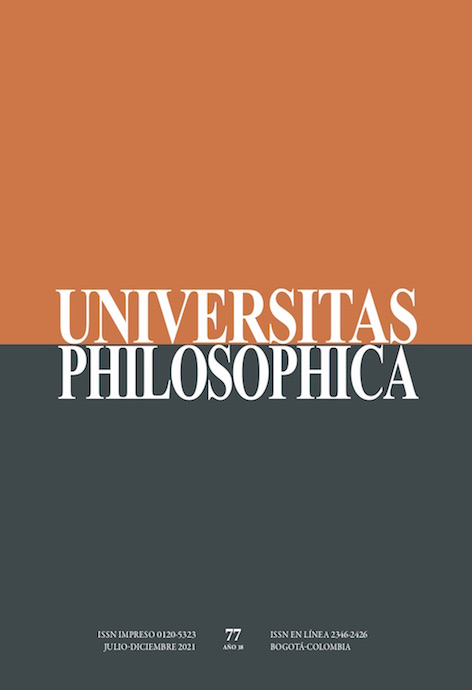Abstract
In the philosophy of Hannah Arendt, the meaning or sense of phenomena has a character of disclosure. The question that motivates this research is how spectators arrive at this revealed meaning. To answer it, I divide the text into three moments. First, I argue that from the perspective of thinking, disclosure is phenomenological in nature, so the spectator’s task would be that of contemplation after questioning prejudices. Second, I argue that from the perspective of the judgment, the disclosure would consist of a dokei moi (‘it seems to me’), and would imply a hermeneutical exercise on the part of the spectators. Third and lastly, I conclude that the disclosure of meaning connects the phenomenological and hermeneutical methods, as it is both perceived and interpreted by a community of spectators.
Arendt, H. (2002a). La vida del espíritu. Paidós.
Arendt, H. (2002b). Comprensión y política. Daimon, Revista de losofía, 26, 17-30.
Arendt, H. (2003). Conferencias sobre la losofía política de Kant. Paidós.
Arendt, H. (2005). Ensayos de comprensión 1930-1954. Caparrós.
Arendt, H. (2006). Hombres en tiempos de oscuridad. Gedisa.
Arendt, H. (2007). Responsabilidad y juicio. Paidós.
Arendt, H. (2011). La condición humana. Paidós.
Arendt, H. (2016). La promesa de la política. Booket.
Beiner, R. (2003). Hannah Arendt y la facultad de juzgar. En H. Arendt, Conferencias sobre la filosofía política de Kant (pp. 157-270). Paidós.
Birulés, F. (2007). Una herencia sin testamento. Herder.
Campillo, N. (2002). Comprensión y juicio en Hannah Arendt. Daimon Revista Internacional de Filoso a, 26, 125-140. https://revistas.um.es/daimon/article/view/11911
Camps, V. (2006). La moral como integridad. En M. Cruz (Comp.), El siglo de Hannah Arendt (pp. 63-85). Paidós.
Di Pego, A. (2012). La revelación del quién en el mundo contemporáneo. Consideraciones a partir de las concepciones de Hannah Arendt y de Paul Ricœur. Revista de Filosofía y Teoría Política, 43, 45-78. http://www.memoria. fahce.unlp.edu.ar/art_revistas/pr.5579/pr.5579.pdf
Di Pego, A. (2016). La comprensión como perspectiva metodológica en Hannah Arendt. Andamios, 13(31), 61-83. http://www.scielo.org.mx/pdf/anda/ v13n31/1870-0063-anda-13-31-00061.pdf
Platón (1988). Teeteto. En Diálogos V (pp. 137-318; M. I. Santa Cruz, Á. Vallejo Campos y N. L. Cordero, Trad.). Gredos.
Porcel, B. (2018). Hannah Arendt: El “quién”, una antropología para la filosofía política. Pensando. Revista de filosofía, 3(17), 126-138. http://doi. org/10.26694/pensando.v9i17.7377.g4442
Rodríguez Suárez, L. (2011). Fenomenología y política en el pensamiento de Hannah Arendt. Investigaciones filosóficas, 3, 419-431. https://www2.uned.es/dpto_m/InvFen/InvFen_M.03/pdf/27_RODRIGUEZ.pdf
Sanabria Cucalón, M. C. (2018). Constitución de la conducta moral en la filosofía de Hannah Arendt: el testigo en el pensamiento y en el mundo de las apariencias. Perseitas, 6(1), 23-47. https://doi.org/10.21501/23461780.2681
Vallejo Campos, A. (1988). Introducción. En Platón, Diálogos V (pp. 139-172). Gredos.
Villalobos, O. (2002). El concepto de Verdad en Hannah Arendt. Una lectura desde la óptica de la comunicación. Utopía y Praxis Latinoamericana, 7(16), 53-66. https://www.redalyc.org/articulo.oa?id=27901605
Wellmer, A. (1996). Hannah Arendt sobre el juicio: La doctrina no escrita de la razón. En F. Birulés (Ed.), Hannah Arendt: El orgullo del pensar (pp. 259-280). Gedisa.
Young-Bruehl, E. (1993). Hannah Arendt. Edicions Alfons el Magnánim.

This work is licensed under a Creative Commons Attribution 4.0 International License.
Copyright (c) 2021 Maria Camila Sanabria Cucalón


